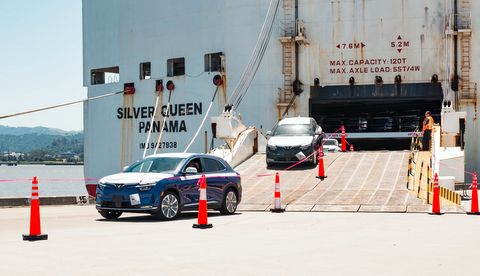Insights from the Front Lines
In the rapidly evolving landscape of electric vehicles (EVs), safety and logistics emerge as pivotal components underpinning the sector’s sustainability ambitions. The incident two years ago involving a cargo ship carrying nearly 4,000 Volkswagen Group vehicles, which succumbed to a devastating fire, starkly illustrates the latent risks and complexities inherent in EV transportation. The latest on that episodes is a suit charging that an electric car battery fire was the source cause of the disaster. As we navigate these turbulent waters, it’s imperative to dissect the multifaceted challenges and strides being made in the realm of EV safety and shipping.
The Reality of EV Fire Risks

During long-distance shipping, electric vehicles require meticulous attention to battery state of charge (SoC), with industry best practices recommending maintaining the SoC at a moderate level of 30-60%. This careful management minimizes stress on the battery, enhancing safety and preserving battery health over the shipping journey.

Contrary to the sensationalist narratives often portrayed, EVs exhibit a lower incidence of fire outbreaks compared to their gasoline-powered counterparts. However, the nature of lithium-ion battery fires in EVs introduces unique firefighting challenges. These batteries, when compromised, can undergo a thermal runaway—a condition where increasing temperature leads to a self-sustaining cycle of heating and breakdown, making containment particularly arduous.
Understanding and mitigating these risks is not just about enhancing battery design, but also about equipping emergency responders with the knowledge and tools to effectively manage such incidents. The development of robust safety protocols and the integration of advanced thermal management systems are at the forefront of reducing the likelihood and impact of battery fires.
The Complexities of Shipping Electric Vehicles
Shipping EVs is fraught with logistical hurdles, magnified by the stringent regulations governing the transport of lithium-ion batteries. The International Air Transport Association (IATA) mandates rigorous standards to ensure the safe air freight of these batteries, reflecting their potential hazard if damaged or improperly handled. Moreover, the added weight of EV batteries influences not only the energy consumption of transport vessels but also the economics of shipping, adding layers of complexity to logistics planning and execution.
Electric vehicles, on average, are approximately 25% heavier than their traditional counterparts, necessitating specialized handling and logistical considerations during shipping. This added weight, coupled with potential variations in ground clearance, introduces unique challenges in the loading and unloading processes, underscoring the need for tailored shipping strategies for EVs.
Innovations in packaging and handling protocols are being developed to address these challenges, aiming to ensure the safe and efficient movement of EVs across global supply chains. These advancements, coupled with ongoing efforts to streamline regulations, are pivotal in facilitating the seamless transport of EVs, bolstering the industry’s growth trajectory.
Innovations in EV Safety and Shipping

The path forward is illuminated by cutting-edge innovations in battery technology and safety measures. Enhanced thermal management systems and the advent of non-flammable electrolytes are among the promising developments aimed at curtailing the risk of battery fires. In parallel, the industry is witnessing the emergence of specialized packaging solutions designed to mitigate the risks associated with the transportation of lithium-ion batteries.
These technological strides, underscored by a collaborative ethos among industry stakeholders, are instrumental in forging a safer, more resilient EV ecosystem. From standardized safety practices to the harmonization of international shipping regulations, the concerted efforts of manufacturers, regulators, and researchers are laying the groundwork for a future where EV transportation is synonymous with safety and reliability.
The Road Ahead
As we stand on the cusp of a transportation revolution, the journey ahead for EVs is as promising as it is fraught with challenges. The continuous pursuit of innovation in safety and logistics remains a cornerstone of the industry’s efforts to redefine mobility. Emphasizing the importance of safety, not as an afterthought but as a fundamental principle guiding the development and distribution of EVs, is paramount.
The incident aboard the Volkswagen Group ship serves as a poignant reminder of the stakes involved. It compels us to advance the dialogue around EV safety and logistics, ensuring that the transition to electric mobility is marked not only by technological breakthroughs but also by an unwavering commitment to safeguarding lives and property.

3 thoughts on “Navigating the Waters of EV Safety and Shipping”